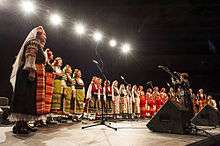Bulgarian State Television Female Vocal Choir
| The Mystery Of Bulgarian Voices | |
|---|---|
 | |
| Background information | |
| Also known as | Bulgarian State Radio and Television Female Vocal Choir, Le Mystère des Voix Bulgares. The Mystery Of The Bulgarian Voices |
| Genres | Folk, World Music |
| Years active | 1952–present |
| Labels | Disques Cellier, Nonesuch, 4AD, Polygram, Rhino |
| Associated acts | Trio Bulgarka, Angelite - The Bulgarian Voices |
The Bulgarian State Television Female Vocal Choir is an internationally renowned World Music ensemble that performs modern arrangements of traditional Bulgarian folk melodies. It is most recognized for its contribution to Marcel Cellier's Le Mystère des Voix Bulgares (The Mystery Of The Bulgarian Voices) project. First created in 1952 as the Ensemble for Folk Songs of the Bulgarian Radio[1] by Georgi Boyadjiev, the choir is now under the direction of Dora Hristova. The choir was granted the name Le Mystère des Voix Bulgares by Marcel Cellier in 1997, in recognition of the fact that it had contributed most of the songs on the original compilations.[2][3]
Membership and methods
Singers are chosen from country villages for the beauty and openness of their voices, and they undergo extensive training in the unique, centuries-old singing style. Influenced by Bulgaria's Thracian, Bulgarian, Ottoman and Byzantine history, their music is striking in its use of diaphonic singing and distinctive timbre, as well as its modal scales and dissonant harmonies (abundant second, seventh, and ninth intervals).
History
Though the choir became widely known when the trend-setting English alternative record label 4AD reissued a pair of anthology albums in 1986 and 1988 with the now famous title Le Mystère des Voix Bulgares, their recordings date as far back as 1957. The first pressing of the Voix Bulgares album was the result of fifteen years of work by Swiss ethnomusicologist and producer Marcel Cellier and was originally released in 1975 on his small Discs Cellier label. Ivo Watts-Russell, the founder of the 4AD Records label, was introduced to the choir from a third or fourth generation audio cassette lent to him by Peter Murphy, singer from the band Bauhaus. He became thoroughly entranced by the music, and tracked down and licensed the recordings from Cellier.[4] They were one of four choirs who appeared on the album Le Mystère des Voix Bulgares, Volume Two, which won Cellier a Grammy Award in 1989.[5][6] The group has since performed extensively around the world to wide acclaim.
The Trio Bulgarka
Three prominent soloists of the group have also performed together as the Trio Bulgarka, notably on the Kate Bush albums The Sensual World and The Red Shoes. The whole ensemble performed with the Italian rock band Elio e Le Storie Tese in the single Pipppero released from the album İtalyan, rum casusu çikti.
The Xenaverse connection
The choir became best known in the United States for its contributions to the music of Xena: Warrior Princess, whose theme music Joseph LoDuca developed from "Kaval sviri," one of the traditional Bulgarian folk songs that form the bulk of their known repertoire.
Discography
- 1975 Le Mystère des Voix Bulgares, Compilation, Disques Cellier
- 1987 Cathedral Concert (Live), PolyGram (re-released in 1992)
- 1988 Le Mystère des Voix Bulgares, volume II, Disques Cellier
- 1989 Le Mystère des Voix Bulgares, volume III, Disques Cellier
- 1993 From Bulgaria with Love: the Pop Album, Rhino/Atlantic
- 1993 Melody Rhythm & Harmony, Rhino/Atlantic
- 1994 Ritual, Nonesuch/Elektra
- 1995 Box Set: Le Mystère des Voix Bulgares, volumes I - II and Ritual, Nonesuch/Elektra
- 1998 Le Mystère des Voix Bulgares, volume IV, Philips
- 2001 Bulgarian Custom Songs, Gega
- 2003 A Portrait of Nikolai Kaufmann, Riva Sound / KVZ Music Ltd.
- 2008 Music From Alone in the Dark, composed by Olivier Derivière, Milan Records
- 2013 Angelina, Jaro 4310-2
See also
References
- ↑ Rice, Timothy (1994). May it fill your soul : experiencing Bulgarian music. Chicago: The University of Chicago press. pp. 27,325. ISBN 9780226711225.
- ↑ Burton, Kim (November–December 2010). "Le Mystère des Voix Bulgares" (PDF). Songlines. pp. 66–67. Retrieved 22 July 2014.
- ↑ Coranova, Goranka; Letnikova, Iva (20 January 2005). "The Mystery of Bulgarian Voices in 2004". Bulgarian National Radio. Archived from the original on 26 January 2005.
- ↑ Troughton, Richie (1 December 2011). "4AD Founder Ivo Watts-Russell On Le Mystère Des Voix Bulgares". The Quietus. Retrieved 22 July 2014.
- ↑ Buchanan, Donna A. (2006). Performing democracy : Bulgarian music and musicians in transition. Chicago, Ill. [u.a.]: Univ. of Chicago Press. p. 489. ISBN 9780226078267.
- ↑ "Past Winners". Grammy.com. National Academy of Recording Arts and Sciences. Archived from the original on 21 July 2014.
External links
- The Mystery of Bulgarian Voices
- 4AD Artist page
- 1988 NY Times concert review
- Singers.com listing
- Video of performance on Johnny Carson's Tonight Show